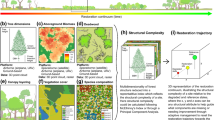Abstract
A subjective visual assessment of foliage density is the mostwidely used rapid method of determining forest health. Forthese assessments to be ecologically meaningful they must bereliable (have low inter- and intra-observer variability) andreadily relate to a measure of physiological or physicalstress. A simple rapid method for assessing percent foliagedensity in lower stature trees is described. This method haslow inter-observer variability (standard deviation betweenobservers=8.6%) and therefore, minimizes the risk ofconfounding the effects of different observers with genuinechanges in density. The percentage changes in this measure offoliage density correlate well with percentage changes inbiomass, allowing a ready interpretation of observed changes.The technique does not specifically identify the cause of themeasured changes, however, with appropriate additionalmeasures this problem may be overcome.
Similar content being viewed by others
References
Bosshard, W. (ed.): 1986, Kronenbilder. Eidgenossische Anstalt fur das forstliche Versuchswesen, Birmensdorf.
Hinrichsen, D.: 1986, ‘Multiple pollutants and forest decline’, AMBIO 15, 258–265.
Hunter, I. R., Rodgers, B. E., Durringham, A., Price, J. M. and Thorn, A. J.: 1991, An atlas of radiata pine nutrition in New Zealand, Ministry of forestry, Rotorua. Forest Research Institute bulletin no. 165, 24p.
Innes, J. L.: 1988, ‘Forest health surveys: problems in assessing observer objectivity’, Can. J. For. Res. 18, 560–565.
Innes, J. L.: 1993, Forest health. Its assessment and status, CAB International, Wallingford, U.K.
Innes, J. and Boswell, R. C.: 1990, ‘Reliability, presentation, and relationships among data from inventories of forest condition’, Can. J. For. Res. 20, 790–799.
Innes, J. L., Landmann, G. and Mettendorf, B.: 1993, ‘Consistency of observations of forest tree defoliation in three European countries’, Environ. Monit. Assess. 25, 29–40.
Landsberg, J.: 1989, ‘A comparison of methods for assessing defoliation, tested on eucalypt trees’ Aust. J. Ecol. 14, 423–440.
Leutert, A.: 1988, ‘Mortality, foliage loss, and possum browsing in southern rata (Metrosideros umbellata) in Westland, New Zealand’, N.Z. J. Botany 26, 7–20.
Lick, E. and Krapfenbauer, A.: 1986, ‘Terrestrische Waldzustands-inventuren und Probleme einer Objektivierung’, Centralbl. Gesamte Forstwes. 103, 227–241.
Meads, M. J.: 1976, ‘Effects of opossum browsing on northern rata trees in the Orongorongo Valley, Wellington, New Zealand’, N.Z. J. Zool. 3, 127–139.
Neumann, M. and Stowasser, S.: 1987, Waldzustandsinventur zur Objektivitat von Kronenklassifizierungen. In Forstliche Bundesversuchsanstalt Wien, Jahresbericht 1986. Forstliche Bundesversuchsanstalt, Vienna. pp. 101–108.
Payton, I. J., Forester, L., Frampton, C. M. and Thomas, M. D.: 1997, ‘Response of selected tree species to culling of introduced Australian brushtail possums (Trichosurus vulpecula) atWaipoua forest, Northland, New Zealand’, Biol. Cons. 81, 247–255.
Pekelharing, C. J., Frampton, C. M. and Suisted, P. A.: 1998, ‘Seasonal variation in the impacts of brushtailed possums (Trichosurus vulpecula) on five palatable plant species in New Zealand Beech (Nothofagus) forest’, N. Z. J. Ecol. 22(2), 141–148.
Rehfuess, K. E.: 1989, ‘Acidic decompositions-extent and impact on forest soils, nutrition, growth and disease phenomena in Central Europe: a review’, Water Air Soil Pollut. 48, 1–20.
Roelofs, J. G. M. and Van Dijk, H. F. G.: 1987, The Effect of Airborne Ammonium Deposition on Canopy Ion-Exchange in Coniferous Trees, Commission of the European Community, Brussels. Air Pollut. Res. Rep. No. 4, pp. 34–39.
Solberg, S.: 1994, Local County Monitoring Plots. Vitality Survey and Control 1994, Research paper of Skogforsk. As. Norway. 19/93: 1–10. [In Norwegian with summary in English.]
Strand, G.-H.: 1996, ‘Detection of observer bias in ongoing forest health monitoring programmes’, Can. J. For. Res. 26, 1692–1696.
Sutton, W. J.: 1981, Data Recording Manual for Defoliator Damage Assessment for Conifers in NewFoundland, Newfoundland Forest Research Centre, Information report N-X-197.
Wickman, B. E.: 1979, How to estimate defoliation and predict tree damage, U.S.D.A. Handbook No. 550, 15 p.
Author information
Authors and Affiliations
Corresponding author
Rights and permissions
About this article
Cite this article
Frampton, C.M., Pekelharing, C.J. & Payton, I.J. A Fast Method for Monitoring Foliage Density in Single Lower-canopy Trees. Environ Monit Assess 72, 227–234 (2001). https://doi.org/10.1023/A:1012049205475
Issue Date:
DOI: https://doi.org/10.1023/A:1012049205475




